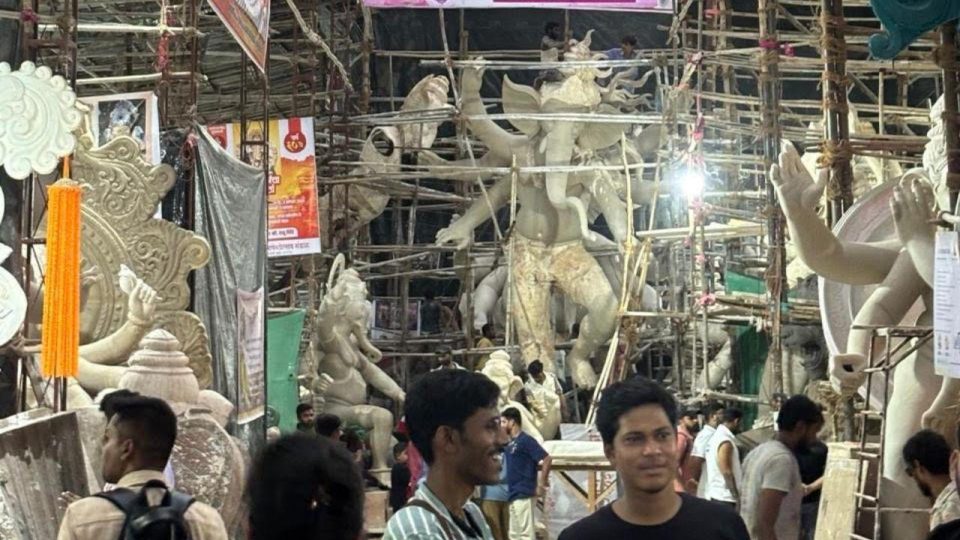
With Ganeshotsav just around the corner, Mumbai’s murtikars (idol makers) are once again in the spotlight, but this year under a different set of challenges.
No ban, but conditions apply
There is currently no ban on manufacturing or selling PoP idols in Mumbai. In June 2025, the Bombay High Court lifted its earlier ban, permitting PoP idols under strict conditions. While the court has now allowed the manufacturing and sale of PoP idols to resume, it made it clear that such idols cannot be immersed in natural water bodies. Authorities believe this compromise addresses both environmental concerns and artisans’ livelihoods, ensuring PoP idols do not end up polluting natural water bodies like rivers, lakes, and the sea.An artisan painting a Lord Ganesha idol at the Parel workshop in Mumbai. Pic/ Ronak Mastakar
Why the restrictions?
PoP idols take months to dissolve, releasing harmful chemicals and gypsum that degrade water quality and threaten aquatic life. Following directions from the Central Pollution Control Board (CPCB) and the National Green Tribunal (NGT), the Maharashtra Pollution Control Board (MPCB) has enforced stricter monitoring this year.
“PoP idols release pollutants into water bodies. Traditions cannot come at the cost of the environment,” said a BMC official.
Murtikars speak
Artisans say the back-and-forth on the PoP ban has created confusion and stress during their busiest season.
“The High Court first banned PoP idols and then lifted the ban. Because of the late decision, mandals placed orders at the last minute, forcing us to work day and night,” said Raju Shinde, who makes Ganpati idols as tall as 25–30 feet at the Parel railway workshop.
“I don’t think PoP should be banned. It is not harmful if handled properly,” he added.
Uday Ramkrishna Khatu, a well-known murtikar from Lalbaug, expressed similar concerns. “Because of the earlier ban and later relaxation, pricing and manpower have been badly affected. Many of us had to decline orders. Instead of banning POP, authorities should regulate the height of idols — ideally between 6 to 8 feet.”Raju Shinde at Parel workshop in Mumbai. Pic/ Ronak Mastakar
Lack of support from BMC
Several artisans also complain of insufficient help from civic authorities. “BMC is not supporting murtikars. It has not allotted spaces for us to build idols despite a state government resolution directing it to do so last year,” said Raju Shinde.
For Mumbai’s idol makers, Ganeshotsav is their main source of income. Despite the relief from the court, challenges remain. PoP idols are cheaper to make, while clay and eco-friendly materials are more expensive and take longer to mould and dry. Devotees also find clay idols heavy and fragile compared to lightweight PoP versions.
“We have been making PoP idols for decades. Suddenly switching to clay is not easy,” said Ramesh Shinde, a third-generation idol maker from Lalbaug. Another artisan from Lalbaug, added, “PoP allows us to make large idols with fine detailing. With clay, the finish is not the same. Many of us fear losing our livelihood.”
Alternatives to PoP
Despite hurdles, eco-friendly idols are slowly gaining attention. Shadu mati (natural clay) idols dissolve easily in water, while papier-mache idols are lightweight, biodegradable, and versatile. Cow dung idols dissolve quickly and enrich the soil. Many families are also opting for reusable idols made of brass, silver, or stone. Seed-Ganesha idols, made of clay mixed with seeds, sprout into plants after immersion, adding a sustainable touch to the festival.
“Eco-friendly idols not only reduce pollution but also symbolise returning to nature,” said Girgaon resident Milind Vanarse.
Government and civic efforts
To enforce the new rules, the Brihanmumbai Municipal Corporation (BMC) is setting up hundreds of artificial ponds across the city. “We urge citizens to adopt eco-friendly idols and make use of artificial ponds. This will reduce the pollution burden on natural water bodies,” said a senior BMC official.
While POP idols are permitted again, the restrictions mean Mumbai’s murtikars must adapt quickly. Experts say subsidies for eco-friendly raw materials, training for artisans, and awareness campaigns for devotees can ease the transition.
As one young artisan from Dadar puts it: “We want to protect the environment too. All we need is some support so our art and livelihood survive along with tradition.”
Ganeshotsav, after all, celebrates creation and harmony. This year, the challenge is ensuring that devotion and sustainability go hand in hand.


